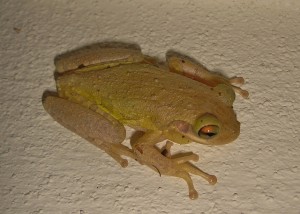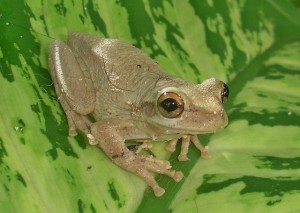The Cuban Tree Frog, Osteopilus septentrionalus, is an invasive non-native species found in the United States that actively preys on native tree frogs such as the American Green Tree Frog, Squirrel Frog, Gray Tree Frog, Pinewoods Tree Frog, and Barking Tree Frog. It has the potential to decimate whole populations of native frogs, and in some locations has done just that.
The Cuban Tree Frog entered this country most likely by stowing away on cargo vessels bringing goods into Key West. The frogs have thrived in Florida’s sub-tropical climate, and in the process of expanding their range, have also displaced native frogs along the way. In fact, the State of Florida is conducting research to determine their full impact.
Shared Habitat
The Cuban Tree Frog is similar in appearance to and can be found inhabiting the same habitat as that of the American Green Tree Frog. They are nocturnal and can be found in backyards, bird baths, and small ponds, in addition to being found infiltrating plumbing systems and electrical boxes where they’ve been reported to cause short circuits.
Cuban Tree Frogs also utilize the same water sources for breeding that other American tree frogs use. The tadpole of the Cuban Tree Frog is as predacious as its adult form and preys on the tadpoles of other species.
Species Description
Cuban Tree Frogs are the largest tree frog in North American, reaching up to 5 1/2″ in length. Their skin is warty, much like that of the toad, and they come in a variety of colors. Their most notable identifying mark is their enormous toe pads which are as large as their external ear. In addition, the skin on the top of their head is fused to the skull.
Impact and Preventive Measures
Studies are being conducted in an attempt to gauge the impact that the Cuban Tree Frog is having on native frog species; however, the Cuban Tree Frog also has had an impact on other species such as small birds whose nest boxes they invade and frighten away. They have even been known to eat small lizards and snakes.
The Cuban Tree Frog is believed to have spread to at least half of the state of Florida. The University of Florida’s Wildlife Extension Program recommends that anyone finding a Cuban Tree Frog humanely euthanize it, but only after positive identification has been made. Digital photos can be submitted to the Wildlife Extension for confirmation.


